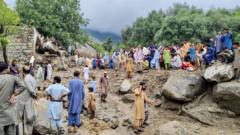Furthermore, Pakistan-administered Kashmir recorded nine additional deaths, while five fatalities were reported in the Gilgit-Baltistan region. Government meteorologists have indicated that heavy rainfall is expected to continue until August 21, leading to alerts for potential further flooding in the northwest. Several areas have officially been designated as disaster zones due to the severity of the situation.
Khyber Pakhtunkhwa’s chief minister, Ali Amin Gadapur, revealed that the rescue helicopter crashed as it was hampered by adverse weather conditions while en route to Bajaur, a border area adjacent to Afghanistan. Distressing images emerged from Bajaur, depicting people gathering around excavators laboriously digging through the mud in such dire conditions.
In the Indian-administered territories of Kashmir, rescuers worked feverishly to recover bodies from the debris left behind by floods that overtook a Himalayan village, resulting in at least 60 fatalities. The monsoon season in South Asia, spanning from June to September, typically accounts for approximately three-quarters of the region's annual precipitation. Historically, landslides and floods have posed significant dangers, and so far this season, over 300 lives have been lost in Pakistan alone. July has proven particularly deadly for areas like Punjab, which is home to around half of the nation's 255 million residents, as rainfall figures skyrocketed to 73% above last year’s levels.
Experts are increasingly asserting that climate change is exacerbating the frequency and intensity of such extreme weather events, amplifying the risks endured by vulnerable populations across the region.
Khyber Pakhtunkhwa’s chief minister, Ali Amin Gadapur, revealed that the rescue helicopter crashed as it was hampered by adverse weather conditions while en route to Bajaur, a border area adjacent to Afghanistan. Distressing images emerged from Bajaur, depicting people gathering around excavators laboriously digging through the mud in such dire conditions.
In the Indian-administered territories of Kashmir, rescuers worked feverishly to recover bodies from the debris left behind by floods that overtook a Himalayan village, resulting in at least 60 fatalities. The monsoon season in South Asia, spanning from June to September, typically accounts for approximately three-quarters of the region's annual precipitation. Historically, landslides and floods have posed significant dangers, and so far this season, over 300 lives have been lost in Pakistan alone. July has proven particularly deadly for areas like Punjab, which is home to around half of the nation's 255 million residents, as rainfall figures skyrocketed to 73% above last year’s levels.
Experts are increasingly asserting that climate change is exacerbating the frequency and intensity of such extreme weather events, amplifying the risks endured by vulnerable populations across the region.



















